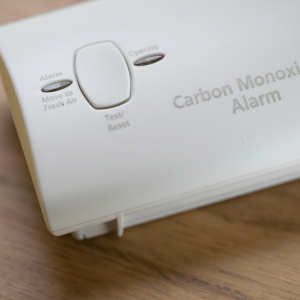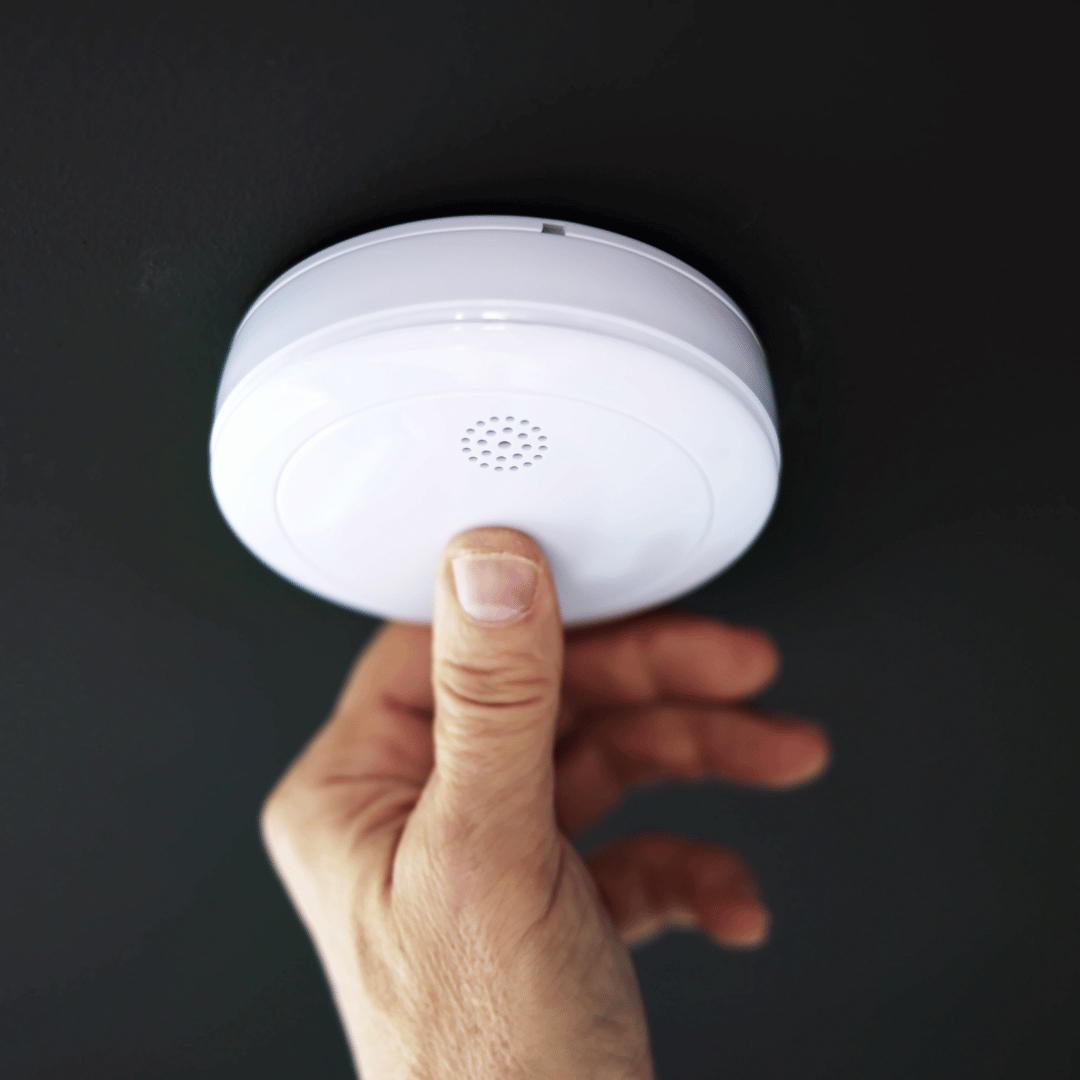
What to Do If Your Carbon Monoxide Detector Beeps and Then Stops
Carbon monoxide (CO) detectors are crucial for maintaining safety in your home. They alert you to the presence of carbon monoxide, a colorless, odorless gas that can be deadly if undetected. When a carbon monoxide detector beeps, it’s a signal that needs immediate attention, but what does it mean if the beeping stops shortly after?
At HomeSmiles, we specialize in preventative home maintenance, ensuring that all aspects of your home, including safety devices like carbon monoxide detectors, are in optimal condition. Our comprehensive 18-point service covers both interior home maintenance and exterior home maintenance, helping you address and prevent potential issues before they become costly repairs.
In this article, we’ll explore what you should do if your carbon monoxide detector beeps and then stops, why it might beep and then go off, whether detectors can malfunction for no reason, and what it means if your alarm beeps four times. Understanding these signals is crucial for maintaining a safe and secure home environment.
Understanding Carbon Monoxide Detector Alerts
Carbon monoxide detectors are designed to alert you to the presence of dangerous levels of CO, but interpreting their signals correctly is essential for ensuring your safety. Here’s a detailed look at what to do and what different beeping patterns might indicate.
What to Do If a Carbon Monoxide Detector Goes Off and Then Stops
- Immediate Actions:
- Check for Symptoms: If your carbon monoxide detector goes off, first check if anyone in the house is experiencing symptoms of CO poisoning, such as headache, dizziness, nausea, or confusion.
- Ventilate the Area: Open windows and doors to allow fresh air to circulate and help disperse any potential carbon monoxide.
- Evacuate If Necessary: If you suspect high levels of carbon monoxide, evacuate the premises immediately and contact emergency services.
- Inspect the Detector: Once it’s safe, check the detector to ensure it’s functioning correctly. Refer to the manufacturer’s instructions for troubleshooting steps.
- Follow-Up Actions:
- Test the Detector: Press the test button to verify the detector is working. If it doesn’t respond, replace the batteries or the detector itself.
- Check for Sources of CO: Identify potential sources of carbon monoxide in your home, such as faulty appliances or blocked vents.
Why Does My Carbon Monoxide Detector Beep Then Go Off?
Carbon monoxide detectors are designed to beep in various patterns to indicate different issues:
- Intermittent Beeping: This often signals that the detector is in alarm mode due to the presence of carbon monoxide. It may beep periodically until the CO levels are reduced to safe levels.
- Short Beeps Followed by Silence: This can indicate a low battery or a malfunction. In such cases, the detector might beep briefly and then stop until the issue is resolved.
Understanding these patterns helps you respond appropriately to the detector’s alerts and maintain a safe living environment.
Can a Carbon Monoxide Detector Go Off for No Reason?
While carbon monoxide detectors are designed to be reliable, they can sometimes go off without a clear reason:
- False Alarms: Common causes include high humidity, cooking fumes, or steam. These conditions can trigger the detector’s alarm, even if there is no actual CO present.
- Sensor Malfunctions: Detectors can malfunction or become less sensitive over time, causing false alarms. Regular maintenance and timely replacement of old detectors can help prevent this.
Why Is My Carbon Monoxide Alarm Beeping 4 Times Then Stops?
Many carbon monoxide detectors use specific beep patterns to indicate different issues:
- Four Beeps: Typically, four beeps followed by a pause indicate a carbon monoxide alarm. This pattern suggests the detector has detected dangerous levels of carbon monoxide and needs immediate attention.
- Resetting the Alarm: After addressing the cause of the alarm, you may need to reset the detector according to the manufacturer’s instructions.
Understanding these beeping patterns and responding appropriately is crucial for maintaining your home’s safety. Integrating regular checks of your detectors into your preventative home maintenance routine can help ensure that they function correctly and provide timely warnings if issues arise.
HomeSmiles Tip: As part of your comprehensive Interior Home Maintenance and Exterior Home Maintenance services, consider having HomeSmiles perform regular inspections of your safety devices. This includes checking detectors and addressing other home maintenance tasks such as Gutter Cleaning, Pressure Washing, and Dryer Vent Cleaning to ensure a safe and well-maintained home environment.
Maintaining Your Carbon Monoxide Detector
Regular maintenance and proactive measures are essential to ensure your carbon monoxide detector functions correctly and provides reliable protection. Here’s how you can maintain your detector and integrate it into your overall home care routine.
Preventative Measures
- Regular Testing:
- Monthly Checks: Test your carbon monoxide detector monthly by pressing the test button. This ensures that the alarm is functioning correctly and the battery is working.
- Battery Replacement: Replace the batteries at least once a year, or according to the manufacturer’s recommendations. Some newer models come with sealed lithium batteries that last up to 10 years.
- Cleaning and Maintenance:
- Dust and Debris: Keep the detector clean by gently vacuuming the exterior and removing any dust or debris that could affect its performance.
- Sensor Replacement: Carbon monoxide detectors have a lifespan, typically around 7 to 10 years. Replace the unit as recommended by the manufacturer to ensure optimal performance.
- Proper Placement:
- Installation Locations: Install detectors on each level of your home, near sleeping areas, and in hallways. Avoid placing them near cooking appliances or high humidity areas, which can trigger false alarms.
- Ventilation: Ensure proper ventilation around the detector to avoid interference with its operation.
The Role of Preventative Home Maintenance
Incorporating carbon monoxide detector maintenance into your broader preventative home maintenance plan ensures that your entire home remains safe and well-maintained. Here’s how it fits into your overall home care:
- Comprehensive Home Checks:
- Interior Home Maintenance: Regularly inspect and maintain all safety devices, including carbon monoxide detectors, as part of your routine interior home checks.
- Exterior Home Maintenance: Address issues that could impact the safety of your home, such as ensuring vents and exhausts are clear and functioning properly.
- Integrating Other Maintenance Tasks:
- Gutter Cleaning: Prevent clogs and overflow that can affect your home’s ventilation and overall safety.
- Pressure Washing: Keep exterior surfaces clean and free from debris that could impact your home’s air quality.
- Window Washing: Ensure clear windows to maintain proper ventilation and avoid buildup that can affect indoor air quality.
- Dryer Vent Cleaning: Prevent lint buildup that can lead to ventilation issues affecting overall home safety.
HomeSmiles Tip: Integrating carbon monoxide detector maintenance into your regular preventative home maintenance routine helps ensure a safe living environment. HomeSmiles offers comprehensive services to address all aspects of home maintenance, from safety devices to exterior cleaning tasks. Regular inspections and maintenance by professionals can help you avoid costly repairs and keep your home in top condition.
By following these maintenance tips and incorporating them into your overall home care routine, you can ensure that your carbon monoxide detector remains effective and reliable, providing peace of mind for you and your family.
HomeSmiles Services
At HomeSmiles, we understand that maintaining a safe and well-functioning home involves more than just checking carbon monoxide detectors. Our comprehensive services cover a wide range of home maintenance needs, ensuring that every aspect of your home is in optimal condition.
Comprehensive Home Maintenance
- Interior Home Maintenance:
- Regular Inspections: Our 18-point interior home maintenance service includes thorough inspections of your safety devices, including carbon monoxide detectors, to ensure they are functioning correctly.
- Preventative Checks: We address common issues such as air quality, ventilation, and overall safety to prevent potential problems before they arise.
- Exterior Home Maintenance:
- Gutter Cleaning: Regular gutter cleaning prevents clogs and overflow, which can impact your home’s ventilation and safety. Clean gutters ensure proper water flow and prevent damage to your home’s exterior.
- Pressure Washing: Our pressure washing services keep your home’s exterior surfaces clean and free from debris that can affect air quality and overall home safety.
- Window Washing: Clear windows not only enhance your home’s appearance but also maintain proper ventilation and natural light, contributing to a healthier living environment.
- Specialized Services:
- Dryer Vent Cleaning: Prevent lint buildup in your dryer vents, which can lead to ventilation issues and potential fire hazards. Regular cleaning ensures safe and efficient operation of your dryer.
- Preventative Home Maintenance: Our approach includes a detailed inspection and maintenance plan to address all aspects of your home, from safety devices to general upkeep. By integrating these tasks into a regular maintenance schedule, we help you avoid costly repairs and ensure a well-maintained, safe home.
Why Choose HomeSmiles?
- Expertise and Experience: With our extensive experience in home maintenance, we provide reliable and thorough services tailored to your specific needs.
- Comprehensive Service: Our 18-point maintenance plan covers both interior and exterior aspects of your home, ensuring that every detail is addressed.
- Preventative Approach: We focus on preventative maintenance to help you avoid unexpected issues and costly repairs.
HomeSmiles Tip: Regular maintenance of your carbon monoxide detector and other home safety devices is just one part of our comprehensive service. Integrate our full range of home maintenance solutions into your routine to keep your home safe, clean, and well-maintained. Contact HomeSmiles today to learn more about how we can help you maintain a secure and comfortable living environment.
Maintaining a safe and healthy home requires regular attention to various aspects of home care, including your carbon monoxide detectors. When your carbon monoxide detector beeps and then stops, it’s essential to understand the cause and respond appropriately to ensure your safety. By following the steps outlined in this article, you can address potential issues promptly and prevent future problems.
Carbon monoxide detectors play a critical role in protecting your home from the dangers of CO gas. Regular maintenance, including testing, cleaning, and timely replacement, helps ensure that these devices function correctly when you need them most. Integrating these maintenance tasks into your broader preventative home maintenance routine will help you keep your home safe and in excellent condition.
At HomeSmiles, we offer a comprehensive range of services designed to address both interior home maintenance and exterior home maintenance. Our 18-point service plan includes essential tasks such as gutter cleaning, pressure washing, window washing, and dryer vent cleaning. By incorporating these services into your regular home care routine, you can prevent costly repairs and maintain a secure and well-maintained home environment.
For expert advice and professional maintenance services, contact HomeSmiles today. Our team is dedicated to helping you ensure that all aspects of your home, including your carbon monoxide detectors, are in optimal condition. Don’t wait for an emergency—take proactive steps to protect your home and your family.
- Protecting Your Property: Why the Right Cleaning Method Makes All the Difference
- The #1 Thing That’s Dulling Your Curb Appeal (And How to Fix It)
- How Maintenance Bundles Provide Peace of Mind for Busy Small Business Owners and Facility Managers
- Essential vs. Complete Home Packages: Choosing the Right Preventive Care for Your Property
- How a Simplified Service Model Benefits Both Homeowners and Franchisees Alike


